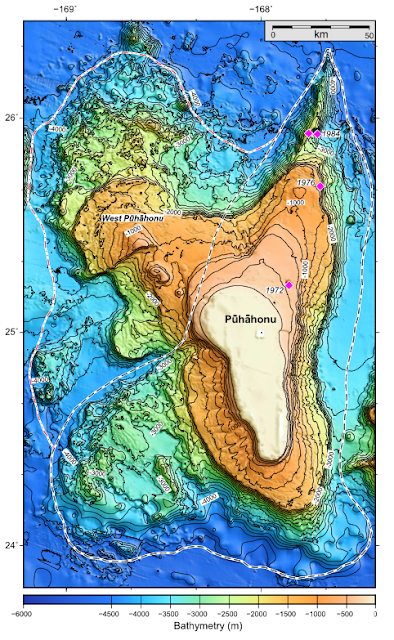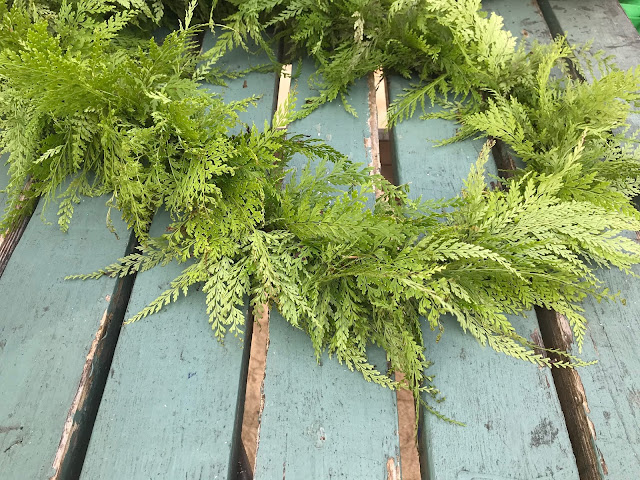I know. I know that as we age, a single day becomes a smaller and smaller fraction of our time alive. And that makes it seem that time goes by faster and faster. But still...how have we arrived near the end of May? So "quickly"?
Itʻs a chill drizzly morning up here. The weathers change dramatically. A week ago CC and I enjoyed a socially distant alfresco takeout Korean BBQ lunch on the deck of a home belonging to long-time friends. This was at the subdivision adjacent to the golf course up here. We last-minute "borrowed" the deck, and had a grand time, aided and abetted by the glorious weather: low humidity, intensely blue nearly cloudless sky, and hot...I got a little sunburned, but it felt sooooo good. That deep sun-baked warmth after a day spent in the sun...memories of countless days at Maniniʻōwali in the 70s and 80s, before it got "discovered" after a road was bulldozed to provide access...
Back in those halcyon days...the 70s and 80s...the sands of Maniniʻōwali held only our footprints, and those of fisherfolk, or those visiting via sailboat for an hour or two. The waters there, of Kua Bay, still sparkled when summercalm, or surged and boomed when winter surf was up.
"The lovely blue of sky and the sapphire of ocean", a favorite line from "Haole Hula" composed by R. Alex Anderson in 1927. Though as seen above, the sky is a lovely blue, and a thin line denotes the sapphire of kai hohonu, the deep ocean, that particular shade of turquoisey Maniniʻōwali Blue is my bestest favorite. The sea is crystal and a few to several feet deep, the sand almost blindingly white...thatʻs it...
And on days when the waves merely lap the shore, calmer than depicted above, and itʻs you and a few friends playing, the word Palanehe seems fitting. In the Andrews Dictionary of 1865:
PA-LA-NE-HE
v. Pala and nehe, to rustle. To be gentle; to be soft and careful in doing a thing; to move softly, without noise.
"Palanehe" was shared by a friend, who had a friend share it with him...describing the soft rustle of seeds shaken by trades, in pods of Lysimachia mauritiana.
This plant, according to some, has an inoa ʻōlelo Hawaiʻi, a Hawaiian name, of "kolokolo kahakai", creeping at the shore. To some minds, kinda basic, and not at all as poetic, methinks, as palanehe.
When ripe and dry, the pods open, and winds shake them, rustling and releasing seeds. I love the evocativeness of "palanehe", and how, if one isnʻt intimately engaged with the plant, weʻd never know the shake and rustle.
We name things, hopefully, based on our experiences of them, their traits, or perhaps in commemoration of an event. Native Hawaiians recognized similarities of relationships as well as differences, and named plants, other things, and phenomena accordingly. So "palanehe", for our native, and uncommon Lysimachia mauritiana, seems entirely fitting.
As fitting, perhaps, as Pūhāhonu, as a name for the volcano and its remnant Gardner Pinnacles, up there in Papahānaumokuākea. Howʻs THAT for a segue?
Note to Readers: when writing these things, my mind is often aswirl in thoughts, tangential or not. I start typing (thanks Ma for strongly suggesting to Honokaʻa School that a typing class with Mr Capellas was more appropriate than Shop for me. How I remember the electric IBM Selectric, and my little electric Smith Corona. But I digress...) I start typing without outline or plan, just a bunch of ideas and notes.
Last week, for a couple days, I was consumed by news of Pūhāhonu. A BIG volcano, bigger than our Maunaloa, made the news after publication of a paper about it.
I had never heard of Pūhāhonu, but HAD heard of Gardner Pinnacles. So there I went, phone calling, and emailing, and perhaps texting too, a number of friends and acquaintances to see what I could learn about this "new" thing.
In short (Iʻll TRY to be short, but we know how THAT sometimes goes), Papahānaumokuākea Marine National Monument is huge, and comprised mostly of Pacific waters above and surrounding remnants of volcanoes, part of Ka Pae ʻĀina Hawaiʻi, the Hawaiian archipelago. The northernmost remnant is variously named Hōlanikū, Moku Pāpapa, or Kure Atoll. Names are complicated.
This is when Ocean Island (yet another name for Kure) went to become Moku Papapa, a document from the State Archives, shared with me by Larry Kimura.
A thought: Back in the old days, centuries ago, somebody from Kauaʻi might sail north and find something: land, reef, shoal. Theyʻd likely give it a name as a reference point. Maybe somebody from Kaʻū or elsewhere would sail north, and do the same thing, but come back, of course, with a different name. Repeat, repeat, repeat. Maybe throw in the waʻa arriving from the south making landfall UpThere. We end up with communities with varying names for the same places or things. Culture and society evolves, and places UpThere become imbued with a Special Ritual Specialness. They may become kapu. Places for aliʻi ritual practices. Places like Ke Alanui Polohiwa a Kāne, the Tropic of Cancer at 23.5 degrees north latitude, the northernmost reach of the sun, which passes through Mokumanamana (Necker Island).
GoLook the National Oceanic and Atmospheric Administration (NOAA) chart (map) #19007
https://www.charts.noaa.gov/ChartCatalog/PacificIslands.html
Select, as above, the sub-region PI3. Donʻt be annoyed at the "Hawaiʻian" spelling. Itʻs usually an AutoCorrect spelling thing. Search for Chart No. 19007
Hereʻs a portion. Mokumanamana (Necker) is just at 23.5 degrees N...
Soundings (all those numbers) are in Fathoms (6 feet).
Ritual...Mokumanamana at the time of Ke Alanui Polohiwa a Kāne, the summer solstice. And other islands, islets, reefs, shoals, etc., also held ritual significance.
Hereʻs a list of names of features in Ka Pae ʻĀina Hawaiʻi , from Bishop Museum, shared with me by Puakea. It was compiled by Kaiʻaikawaha in 1835 at Lahainaluna.
Names, a dizzying array, some familiar, some not, from one tradition.
Then in the journal Hūlili, v6 in 2010, a similar list from Kekuewa Kikiloi, who has done extensive research in the region. Hāʻena is perhaps an older name for Mokumanamana.
https://scholarspace.manoa.hawaii.edu/bitstream/10125/101211/Kikiloi_Scott_r.pdf
His dissertation is one to read, re-read, study, ponder, etc...
Going back...in Ka Hoku o ka Pakipika, November 28, 1861 is a reference to Onuiki and Onunui (ʻŌnūiki and ʻŌnūnui), as well as Nihoa and (Ka)mokumanamana...
The ʻŌnū names, for Gardner Pinnacles (remember them?) are seen on the map below on the Papahānaumokuākea website, along with many of the 1835 names.
And then, the map below, courtesy of John Smith at UH Mānoa, an author of the Pūhāhonu paper. Itʻs of Pūhāhonu, a name given by the Hawaiian Language Lexicon Committee in the late 90s. Pūhāhonu is also called Nā ʻŌnū, or Gardner Pinnacles, or ????? Because this image resulted from undersea mapping, the black blebs indicate "No Data Gathered". Above-water remnants. Compare with the image above.
From a list shared with me by Larry Kimura...
PŪHĀHONU - (Gardner Pinnacles) These isolated two islands and various rock outcroppings, the farthest west of the lava islands, and which seems to appear unexpectedly at sea, reminds one of a turtle coming up for air, emerging with its back and top of its head above the surface. It has been observed that although turtles are rarely seen on the main islands, they can be seen resting on a crevice or shelf at Pūhāhonu - the surfacing of a turtle for air.
A similar iteration was published in the 3rd Edition of the Atlas of Hawaiʻi in 1998. Iʻm adding it here Tuesday morning, 052620, after locating it yesterday, so we might have various sources in one place.
Said list was generated in the mid-90s:
Take a walk around the room, sip some tea...
My thoughts: Places in remote regions of Ka Pae ʻĀina Hawaiʻi were infrequently visited. Numbers of names were given to the same place(s). The places are mentioned in ancient chants and traditions, in logs, journals, and exploration notes of travelers, both kamaʻāina and malihini, and often the names are different. What Larry said above is that research was conducted, and it was found that (often) different sources and traditions gave different names for the same place or feature. The Lexicon Committee decided to come up with a new (neutral) list of names, Pūhāhonu being one of them. The authors of the Pūhāhonu paper, after consulting with Native Hawaiian cultural sources, chose to refer to the entire massive volcano, not just The Pinnacles, as Pūhāhonu, the image below is in their paper.
Those of us who like things sorted tidily into proper boxes or stacks are disoriented when being tidy and organized doesnʻt fit into the scheme of things; of the works of others.
I enjoy the wondering, the learning. Although it sometimes makes me crazy or unsettled, not infrequently there are no set answers or outcomes. Iʻm learning that thatʻs OK. Learning the different names encourages expansive thinking. There is no one singular answer. And perhaps that adds to mystery and reinforces the fact that there exists many different traditions and schools of thought:
ʻAʻohe pau ka ʻike i ka hālau hoʻokāhi
All knowledge is not taught in the same school
One can learn from many sources
ʻŌlelo Noʻeau #203, collected by Mary Kawena Pukui
And yes, this Dispatch has been all over the place. Itʻs not boxed and tied with a pretty bow. There are dangling threads and missing pieces, and things that donʻt make sense, to us, at the moment. All the more reason to continue to explore!
Thereʻll be other posts related to this. Burning questions may be sent to me via email or phone or snail mail...
As always, with aloha. Be Well, Wear a Mask, No Get Crazy...
BobbyC
maniniowali@gmail.com












































































